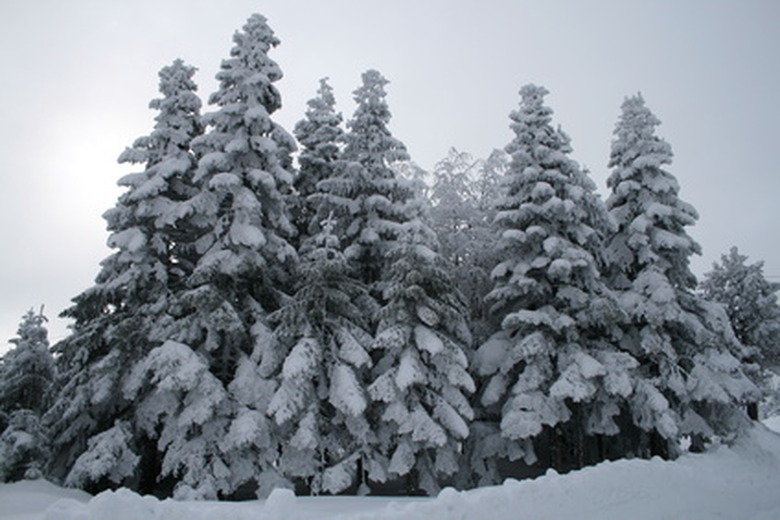How To Care For Hemlock Trees
Things Needed
- Hemlock root ball
- Peat moss
- Mulch
- Fertilizer
- Insecticide
The hemlock tree is often confused with the poisonous plant ancient peoples used to make a lethal drink. To the contrary, Native Americans once brewed a medicinal tea from the leaves and branches, according to William Carey Grimm's "The Illustrated Book of Trees: The Comprehensive Field Guide to More Than 250 Trees of Eastern North America." In modern times, hemlock's evergreen needles and drooping stems yield a finely textured landscape tree, often used as a specimen, screen or group planting.
Step 1
Plant hemlock in partial shade or sun, preferably in moist, well-drained soil. Do not place a hemlock near a foundation, because the tree can outgrow a site if it is not pruned annually. Avoid curbside plantings as hemlock is sensitive to road salt in winter.
Step 2
Amend the soil before transplanting to improve drainage. With the exception of clay soils, you can apply a 2- to 4-inch layer of peat moss or sand to the area, then till the material deep into the soil to increase porosity.
- The hemlock tree is often confused with the poisonous plant ancient peoples used to make a lethal drink.
- With the exception of clay soils, you can apply a 2- to 4-inch layer of peat moss or sand to the area, then till the material deep into the soil to increase porosity.
Step 3
Dig a hole two to three times the size of the Hemlock root ball. Place the root ball in the hole, and then replace the soil. Avoid setting the tree deeper in the soil than it grew in the nursery. Try to maintain the original soil line.
Step 4
Provide a transplanted tree with 1-inch of water weekly until established. A soaker hose allows water to trickle down to the root zone and prevent the root ball from drying out. Thereafter, water during periods of drought to reduce plant stress.
- Dig a hole two to three times the size of the Hemlock root ball.
- Provide a transplanted tree with 1-inch of water weekly until established.
Step 5
Spread a 3-inch layer of mulch around the base of the trunk. Mulches, such as pine straw, leaves and pine bark, prevent weed competition during establishment and help the soil and roots retain moisture. A mature hemlock tree does not require mulch; the low growing branches hinder weed growth.
Step 6
Treat hemlock woolly adelgid infestations with insecticides. The insects feed on the needles and form cottony sacs at the base of the tree and, eventually, kill the tree. Spray the tree twice with horticultural oil or insecticidal soap to control adelgids. Injecting infected stems with insecticide in mid-May helps control adelgids for six months, according to Pennsylvania State University School of Forest Resources' fact sheet on hemlock woolly adelgid.
- Spread a 3-inch layer of mulch around the base of the trunk.
- Mulches, such as pine straw, leaves and pine bark, prevent weed competition during establishment and help the soil and roots retain moisture.
Step 7
Apply a balanced fertilizer to an established tree, not a transplant. The ideal mix contains nitrogen, phosphorus and potassium in 8-8-8 or 10-10-10 ratios. Fertilizer acts as a nutrient supplement, providing the tree with the minerals it needs to fend off disease, drought and pests.
Step 8
Limit spring pruning to individual branches, if a natural pyramidal shape is desired. Prune branches back to the candles, or buds lower on the stem, if a dense, compact habit is preferred. Pinch off 1/2 of each candle by hand. Shears can injure needles and cause the tips to turn brown.
- Apply a balanced fertilizer to an established tree, not a transplant.
- Limit spring pruning to individual branches, if a natural pyramidal shape is desired.
Tip
Remove dead and diseased branches from hemlock trees.
Warning
Do not fertilize the tree during an adelgid infestation. The added nitrogen may increase reproduction.
References
- "The Illustrated Book of Trees (Revised and Updated)"; William Carey Grimm; 2002
- Pennsylvania State University College of Agriculture Science: Hemlock Wooly Adelgid
- University of Wisconsin Cooperative Extension: How to Properly Prune Evergreens
